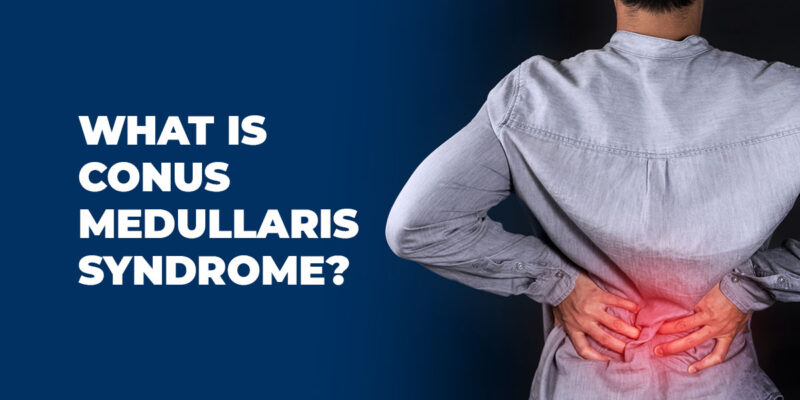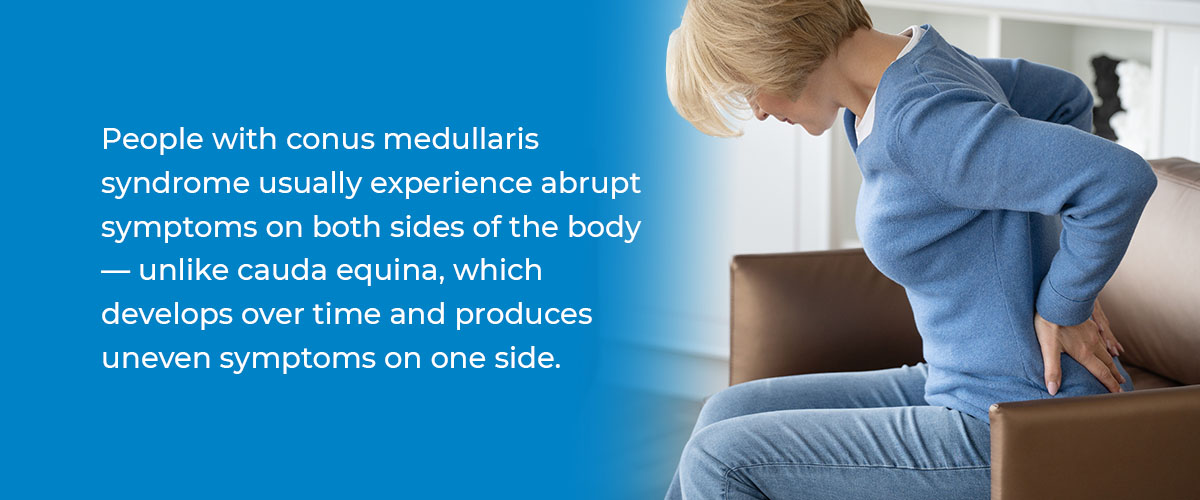

The conus medullaris — a Latin term that means “medullary cone” — is a cluster of spinal cord nerves with a tapered end. It is found near the first two lumbar vertebrae in the back (L1 and L2). The conus medullaris stops at the cauda equina, where nerves and nerve roots are no longer protected and the spinal cord terminates.
In turn, issues with the conus medullaris typically affect the cauda equina. Conus medullaris syndrome is a type of spinal cord damage caused by lumbar vertebrae trauma.
This condition generally results from a spinal cord injury or loss of sensation below the injured area. While it shares similar symptoms with cauda equina syndrome, conus medullaris requires different treatment.
Now that you’re familiar with the conus medullaris definition, learn more about the condition that affects this area, including causes, symptoms, diagnostic methods and treatment options.
Conus medullaris syndrome isn’t necessarily a disease but more so a product of spinal trauma. A blow to the lower back is generally the culprit, but it can also stem from other spinal cord infections and diseases. Some common conus medullaris syndrome causes are:

People with conus medullaris syndrome usually experience abrupt symptoms on both sides of the body — unlike cauda equina, which develops over time and produces uneven symptoms on one side. Below are some common indicators of conus medullaris syndrome:
To diagnose conus medullaris syndrome, a medical professional will likely perform a magnetic resonance imaging (MRI) scan of your lower back and spine. The doctor will consider the type, cause and severity of your spinal injury when identifying this condition.
Treatment can vary depending on the cause and extent of the spinal injury. For instance, radiation therapy may help if your symptoms arose from a cancerous tumor. If your symptoms resulted from a spinal infection — or the severity of your injury led to infection — your doctor might recommend intravenous (IV) or oral antibiotics.
Spinal decompression surgery usually helps treat this condition. Should a physical hindrance remain — like remnants of a bullet or tumor — a surgeon can remove these to restore spinal function. Physical therapy may also be necessary to regain function in your lower back and legs.
Below are two common treatment routes for conus medullaris syndrome.
Surgical intervention is usually necessary to help decompress the conus medullaris, reduce pain and numbness in the lower extremities, and increase space in the spinal canal. It’s typically recommended when non-surgical treatments are unsuccessful. Different types of spinal decompression surgery include:
Following surgery, be sure to reduce strenuous activities like bending and twisting, lifting heavy items, yardwork, housework and intense exercise.
Your doctor will clarify specific activities to limit and avoid during recovery. They can help you determine an appropriate time to resume regular activities. It’s also important to avoid prolonged sitting, as it can weaken your muscles and stunt the healing process. In most cases, pain and discomfort will subside within four to six weeks after spinal decompression surgery.
If you’re returning to a job involving long periods of sitting, continue to care for your back and support spine health. Good posture and an ergonomic chair can help you maintain a comfortable work environment and avoid putting stress on your surgical site.
Your doctor will likely recommend physical therapy sessions to relieve your conus medullaris symptoms, improve mobility and strengthen your muscles. Physical therapy is also an important part of post-surgery recovery. A physical therapist can show you different range-of-motion and strengthening exercises to restore function in the lower extremities.
Depending on your pain levels and symptoms, physical therapy sessions might include:
Physical therapy usually runs two or three times a week for a month or slightly more. Your doctor and therapist will evaluate your progress and determine if additional sessions are needed beyond this point.

You don’t have to let conus medullaris syndrome interfere with your daily activities and life. If you’re seeking relief from this condition, turn to our experienced team at New York Spine Institute.
We offer an array of specialized orthopedic services including diagnostics, neurosurgery, pain management and physical therapy. We can tailor a comprehensive treatment plan to your condition, symptoms, pain levels and needs, paving the road to your recovery.
Our in-house physical therapists and pain management physicians will coordinate with your medical providers, aiming to treat your condition with the most nonintrusive methods. Should you require spinal decompression surgery, our world-class orthopedic spine specialists will guide you through the process and ensure you feel comfortable during the procedure.
When you’re pursuing treatment for spine-related conditions on or near Long Island, New York Spine Institute is the place to turn. Schedule your consultation appointment today to begin treatment for conus medullaris syndrome.